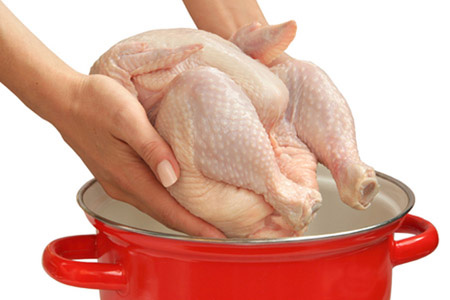Things you should know about handling fresh or frozen chicken
With meat becoming more and more a luxury buy, chicken could well be the most affordable food to prepare for your family. However, there are do's and don'ts when it comes to freezing, defrosting, handling and cooking chicken.
Defrosting chicken
Chicken should never be left on the countertop to defrost. Place chicken on the lowest level in your refrigerator, in an appropriate container, and allow to defrost for at least 3 hours.
Defrosting times depend on the cut of chicken. A whole chicken may take 24 hours to 2 days to defrost. If you know you're going to be having chicken make sure you allow plenty of time for proper defrosting.
Another method for thawing is to place frozen chicken in its original wrapping, or a sealed bag, and place it in cold water, changing the water regularly until the product is defrosted. This method can also be used to defrost a whole chicken, though it may take at least 2 hours.
Frozen chicken may also be thawed in the microwave, though defrosting times will vary. The best way to thaw chicken is by placing it in the refrigerator, allowing enough time between thawing and preparation.
Keep raw chicken away from other foods while thawing. Make sure chicken is properly covered while it is defrosting.
Do not keep uncooked chicken longer than a day in the refrigerator after it has been thawed.
When freezing fresh chicken, note the date of storage on the package or container to preserve freshness.
Always check chicken for signs of spoilage before cooking and consuming. Discard chicken that looks slimy or smells unpleasant.
Chicken can be stored in your refrigerator for up to 2 days. It can be frozen for up to 2 months in its original packaging, or stored in freezer bags for up to 9 months from the date of storage.
Prevent freezer burn by storing chicken in air-tight containers designed for use in freezers. Freezer burn occurs when air reaches the chicken, making it appear brownish and leathery, and resulting in loss of quality and flavour.
Handling chicken
Always wash hands before and after handling raw chicken. A clean working environment is essential in the prevention of contamination. The work area, cutting boards, and utensils must be thoroughly cleaned with hot soapy water after being exposed and should not be used for other foods until properly cleaned. This will prevent cross contamination of bacteria from the chicken to other foods.
Do not let raw chicken or its juices come into contact with other food items.
Cooking chicken
As on any perishable meat, fish or poultry, bacteria can be found on raw or undercooked chicken. They multiply rapidly at temperatures between 10 and 60 degrees C (out of refrigeration and before thorough cooking occurs). Freezing doesn't kill bacteria but they are destroyed by thorough cooking.
Cook chicken thoroughly before consuming to kill food-borne bacteria. An average chicken, cooked in the oven at 180 degrees C, should take around 1 hour and 30 minutes, depending on the size.
Different cuts of chicken require different cooking times and temperatures. Have a meat thermometer handy to ensure that chicken reaches and The U.S. Food Safety and Inspection Service recommends that chicken reach an internal temperature of at least 80 degrees C.

